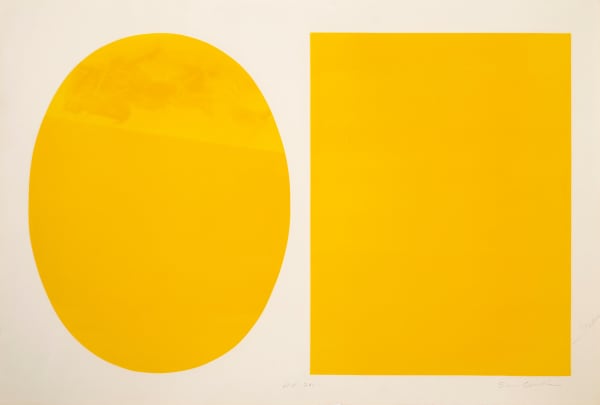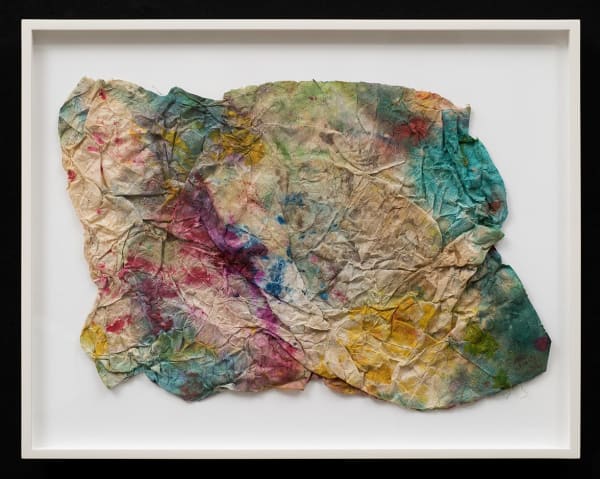Sam Gilliam US, b. 1933
"Although the relation between music and my work isn't so direct, the structure of jazz is important. My Drape paintings are never hung the same way twice. The composition is always present, but one must let things go, be open to improvisation, spontaneity, what's happening in a space while one works."
- Sam Gilliam
Born in Tupelo, Mississippi, in 1933, Gilliam was the seventh of eight children of Sam and Estery Gilliam. Shortly after his birth, the Gilliams moved to Louisville, Kentucky, where the artist spent his childhood. Gilliam’s father worked on the railroad, and his mother was a homemaker for the large family. Gilliam began painting by the time he was in elementary school. In 1951 Gilliam graduated from Central High School in Louisville. He attended the University of Louisville and graduated with a Bachelor of Arts degree in 1955. During that same year he enrolled in graduate school at the University of Louisville, and also had his first solo exhibition at the same institution. Gilliam served in the United States Army from 1956 to 1958. He returned to Louisville following his discharge and completed his master’s degree in fine arts at the University of Louisville in 1961.
Gilliam initially taught art for a year in the Louisville public schools. In 1962 he married Dorothy Butler, a Louisville native and a well-known journalist. That same year, Gilliam moved to Washington, D.C., where he has lived ever since.
The backdrop for Gilliam’s art was the 1950s, which witnessed the emergence of Abstract Expressionism and the New York School followed by Color Field Painting. Although these developments were later to play major roles in Gilliam’s style, he had no direct exposure to these movements during his years at the University of Louisville. An important contemporary influence whom Gilliam acknowledges during that period was Nathan Oliveira, a California figurative expressionist who held an exhibition in Louisville. Two other early influences were the luminous watercolors of Paul Klee, and the works of the German Expressionist group Die Brücke (The Bridge).
Although not an organized or self-conscious movement, one of the most important developments in abstract art to emerge following Abstract Expressionism occurred in Washington, D.C., and is most often designated the Washington Color School. Artists identified with this movement include Morris Louis, Kenneth Noland, Thomas Downing, Paul Reed, Anne Truitt, and Gene Davis. The general course of this style developed from the more painterly abstractions of the 1950s to totally nonrepresentational, expansive, simplified works of clear bright colors through the 1960s. Morris Louis had died and Kenneth Noland had moved to New York by the time Gilliam arrived in Washington in 1962. Their works were well known in Washington, however, and in 1963 Gilliam met Thomas Downing. At that point Gilliam decided to relinquish his earlier, brooding style in favor of nonrepresentational art. His earliest Washington works were large, clean edged paintings with flatly applied areas of color within the stylistic idiom of Washington Color Field Painting. Following that phase, Gilliam created early abstractions of diagonal stripes on square fields. During this time Gilliam experimented by taping and pouring colors, folding and staining canvases, and literally folding a still wet canvas against itself to imprint vertical, angular, and axial forms.
Around 1965 Gilliam became the first painter to introduce the idea of the unsupported canvas. Partially inspired by women hanging laundry on clotheslines he observed from the window of his Washington studio, Gilliam abandoned the frame and stretcher, and began to drape and suspend large areas of paint stained canvas. This innovative and improvisational technique was phenomenally successful and of widespread influence. Gilliam received numerous public and private commissions for his draped canvases, earning him the title “father of the draped canvas.”
These paintings were sometimes suspended from ceilings, arranged on walls, or on floors. They represent a third dimension in painting and impart a sculptural quality. Though installed by the artist, Gilliam’s draped canvases could be rearranged at will, and he has frequently embellished these works with metal, rocks, and wooden beams. One of the largest and final works of Gilliam’s “draped” series was Seahorses,1975 for the Philadelphia Museum of Art. This six-part work involved several hundred feet of paint stained canvas and was commissioned for the exterior walls of two adjacent wings of the museum.
While at the height of his popularity as the creator of draped canvases, in 1975, Gilliam suddenly discontinued producing them and began creating dynamic geometric collages influenced by musicians Miles Davis and John Coltrane. By 1977 Gilliam was producing “Black Paintings”, similar in technique to the collage paintings, but in predominantly black hues. In 1979 Gilliam’s Wild Goose Chase series was inaugurated and featured slanted edges and designs reminiscent of quilt patterns.
Gilliam’s method of paint application changed dramatically during the 1980s. His former technique of staining and saturating wet canvases was replaced by a method in which multiple layers of thick acrylic paint and gels are scumbled, spattered, and built up on the canvas in a rich impasto. Gilliam’s “quilted” paintings of the 1980s involved cutting geometric shapes from his thickly encrusted canvas surfaces and rearranging them on nylon or canvas backgrounds in patterns reminiscent of African American patchwork quilts the artist remembered from his childhood.
Gilliam continues to produce new series, employs enamel as well as acrylic paints, and uses canvas, nylon, and awning materials in conjunction with aluminum and other metals. Gilliam’s ability to move beyond the aesthetic of Washington Color Field Painting has assured his prominence as an exciting and innovative contemporary painter.
An outstanding creator of public art, Gilliam frequently works on a monumental scale and has received numerous major public commissions around the country. Gilliam has received two National Endowment for the Arts awards, fellowships from the Washington Gallery of Modern Art and the Guggenheim Foundation, and an Honorary Doctorate of Humane Letters from his alma mater, the University of Louisville, in 1980.





